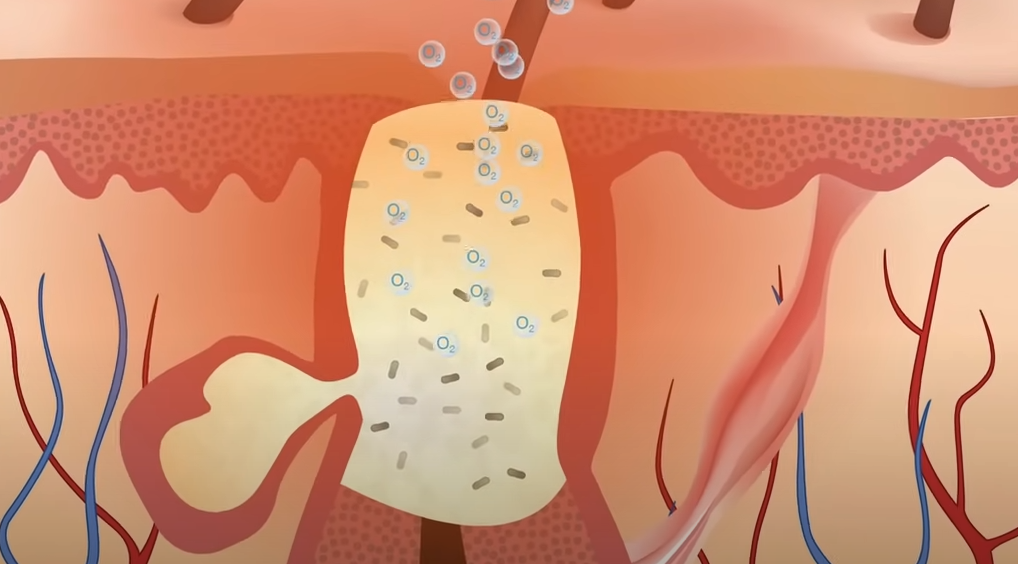Salicylic acid is a common ingredient in acne treatments due to its proven benefits. It works by penetrating deep into the pores, breaking down excess oil and dead skin cells. This helps prevent the clogging of pores, which often leads to breakouts.
By using products with salicylic acid, you can effectively manage acne and maintain clearer skin. In this article, we will examine how salicylic acid contributes to clearer skin and why it might be a good fit for your skincare routine.
How Salicylic Acid Clears Acne?

Salicylic acid is renowned for its effectiveness in treating acne. Its primary function is to exfoliate the skin and unclog pores, making it a staple in many acne treatments.
Exfoliation and Pore Cleansing
Salicylic acid works by penetrating deep into the pores. It breaks down the bonds between dead skin cells, allowing them to be removed more easily. This process helps prevent the formation of clogged pores, which can lead to acne. By keeping pores clear, salicylic acid reduces the likelihood of breakouts and promotes smoother skin.
Anti-Inflammatory Properties
In addition to its exfoliating effects, salicylic acid has anti-inflammatory properties. It helps to reduce redness and swelling associated with acne. This dual action makes it particularly effective for individuals with inflammatory acne, such as papules and pustules.
Reduction of Excess Oil
Salicylic acid also helps to control excess oil production. It breaks down the oil that can accumulate in the pores and contribute to acne formation. By regulating oil levels, salicylic acid helps to maintain a balanced and clear complexion.
How It Compares to Other Acne Treatments

Salicylic acid is often compared to benzoyl peroxide, another common acne treatment. While benzoyl peroxide works primarily by killing acne-causing bacteria, salicylic acid focuses on exfoliation and pore-cleansing.
Benefits for Acne-Prone Skin
Salicylic acid offers numerous benefits for individuals with acne-prone skin. Its unique properties make it a highly effective treatment for various types of acne and skin concerns.
Deep Cleansing of Pores
- Penetration: Salicylic acid penetrates deep into the pores, addressing the root cause of acne by clearing out trapped oil and debris.
- Unclogging: By dissolving the materials that clog pores, it prevents the formation of blackheads and whiteheads.
Reducing Acne Lesions
- Exfoliation: It promotes the shedding of dead skin cells, which helps reduce the formation of new acne lesions.
- Smoother Skin: Regular use can lead to a more even skin texture by preventing the buildup of dead skin cells.
Anti-Inflammatory Effects
- Calming Redness: Salicylic acid reduces inflammation and redness, making it effective for treating inflammatory acne, such as papules and pustules.
- Soothing: It helps to soothe the skin and minimize the discomfort associated with active breakouts.
Regulating Oil Production
- Oil Control: By breaking down excess oil, salicylic acid helps to regulate sebum production and prevent the overproduction of oil that can lead to acne.
- Balanced Skin: This regulation helps to maintain a more balanced and less oily complexion.
Long-Term Skin Benefits
- Prevention: Regular use of salicylic acid can help prevent future breakouts by keeping pores clear and reducing the buildup of acne-causing agents.
- Improved Appearance: Over time, it can contribute to a clearer and more refined skin appearance.
Preventing Breakouts

Salicylic acid plays a crucial role in preventing new breakouts and maintaining clearer skin. Its actions target the underlying causes of acne, making it an effective preventive measure.
Unclogging Pores
- Prevention of Clogged Pores: Salicylic acid helps to dissolve and remove the buildup of dead skin cells and excess oil inside the pores. This prevents the formation of comedones (blackheads and whiteheads), which can lead to more severe acne.
- Regular Use: Consistent application of salicylic acid can help keep pores open and clear, reducing the likelihood of new breakouts.
Reducing Excess Oil
- Oil Breakdown: By breaking down excess sebum, salicylic acid helps to reduce the amount of oil that can contribute to acne. This oil control is essential for preventing new acne from forming.
- Balanced Skin: It helps maintain a more balanced oil production, which can prevent the skin from becoming too oily and prone to breakouts.
Exfoliating Dead Skin Cells
- Preventing Build-Up: Regular exfoliation with salicylic acid helps to remove dead skin cells from the surface of the skin. This prevents these cells from accumulating and clogging pores.
- Maintaining Skin Health: Exfoliation also promotes the turnover of skin cells, which can improve the overall health and appearance of the skin.
Avoiding Future Breakouts
- Long-Term Effectiveness: Regular use of salicylic acid can help maintain clear skin over the long term. By addressing the factors that contribute to acne, it reduces the risk of future breakouts.
- Consistent Routine: Integrating salicylic acid into your daily skincare routine can provide ongoing prevention and support for clear skin.
Reducing Inflammation
Salicylic acid is effective not only for preventing acne but also for managing inflammation associated with breakouts. Its anti-inflammatory properties help soothe irritated skin and reduce the visible signs of acne.
Calming Redness and Swelling
- Anti-Inflammatory Action: Salicylic acid reduces inflammation in the skin, which helps to alleviate redness and swelling often seen with acne.
- Visible Improvement: This reduction in inflammation can lead to a noticeable decrease in the size and redness of pimples, making them less prominent.
Soothing Irritation
- Reducing Discomfort: By calming inflammation, salicylic acid helps to reduce the discomfort and sensitivity that can accompany active breakouts.
- Healing Process: It supports the healing process of inflamed skin, which can help acne lesions heal faster and with less scarring.
Enhancing Skin Appearance
- Even Skin Tone: Reduced inflammation contributes to a more even skin tone by minimizing redness and discoloration associated with acne.
- Improved Texture: As inflammation decreases, skin texture improves, leading to smoother and clearer skin.
Complementary Benefits
- Synergistic Effect: When used in combination with other acne treatments, salicylic acid’s anti-inflammatory properties can enhance the overall effectiveness of a skincare regimen.
- Overall Skin Health: Regular use can contribute to better skin health by managing inflammation and supporting a clearer complexion.
Improving Skin Texture

Salicylic acid contributes significantly to improving skin texture, which can be particularly beneficial for those with acne-prone skin. Its exfoliating properties help refine and smooth the skin’s surface.
Exfoliation of Dead Skin Cells
- Removal of Dead Skin: Salicylic acid promotes the shedding of dead skin cells from the surface. This exfoliation prevents the buildup of dead cells, which can make the skin look uneven and contribute to clogged pores.
- Smoother Surface: By removing the outer layer of dead cells, salicylic acid helps create a smoother and more refined skin texture.
Reduction of Post-Acne Marks
- Fading Hyperpigmentation: Regular use of salicylic acid can help fade post-acne marks, such as dark spots and discoloration. It accelerates skin turnover, which can improve the appearance of these marks over time.
- Even Skin Tone: By enhancing cell turnover and reducing surface discoloration, salicylic acid contributes to a more uniform skin tone.
Minimizing Pore Size
- Pore Appearance: Salicylic acid helps to keep pores clear of debris and excess oil, which can reduce their appearance. Smaller, less noticeable pores can lead to a more even skin texture.
- Improved Clarity: Regular exfoliation helps maintain pore clarity and contributes to a clearer overall complexion.
Long-Term Texture Improvement
- Consistent Use: Over time, consistent use of salicylic acid can lead to significant improvements in skin texture. Regular exfoliation supports ongoing refinement and clarity.
- Overall Skin Health: Improved texture not only enhances the appearance of the skin but also supports overall skin health by promoting effective exfoliation and turnover.
How to Incorporate into Your Routine
Incorporating salicylic acid into your skincare routine can maximize its benefits for acne-prone skin. Here’s how to effectively add it to your regimen.
Choosing the Right Product
- Formulations: Salicylic acid is available in various formulations, including cleansers, toners, serums, and spot treatments. Select a product based on your skin type and specific needs.
- Concentration: Products typically contain salicylic acid in concentrations ranging from 0.5% to 2%. Start with a lower concentration if you have sensitive skin and adjust as needed.
Application Tips
- Frequency: Begin by applying salicylic acid once or twice a week to assess your skin’s tolerance. Gradually increase frequency to daily use if your skin responds well.
- Cleansing: Use a salicylic acid cleanser to help clear pores and remove excess oil. Apply it to damp skin, massage gently, and rinse thoroughly.
- Toning and Treating: Apply a salicylic acid toner or serum after cleansing. This helps to penetrate deeper into the skin and target acne more effectively. Follow the product’s instructions for application.
Combining with Other Products
- Avoid Overlapping: When using salicylic acid, avoid combining it with other strong exfoliants or acne treatments, such as products containing benzoyl peroxide or retinoids, to prevent irritation.
- Moisturizing: Follow up with a non-comedogenic moisturizer to keep your skin hydrated and prevent dryness. Salicylic acid can sometimes lead to dryness or peeling, so hydration is crucial.
Monitoring and Adjusting
- Skin Reaction: Monitor your skin for any signs of excessive dryness or irritation. If you experience redness or peeling, reduce the frequency of use or switch to a lower concentration.
- Consistency: For the best results, incorporate salicylic acid into your daily routine and use it consistently. Improvement in acne and skin texture takes time.
Potential Side Effects

While salicylic acid is generally effective for treating acne, it may cause some side effects in certain individuals. Understanding these potential reactions can help you use the product safely and effectively.
Dryness and Peeling
- Dry Skin: Salicylic acid can cause dryness, especially when used frequently. This occurs as it exfoliates the skin and removes dead cells, which may lead to a reduction in the skin’s moisture levels.
- Peeling: Some users may experience peeling or flakiness as a result of the exfoliating action. This is typically mild but can be managed by adjusting the frequency of use or using a more hydrating moisturizer.
Irritation and Redness
- Skin Sensitivity: Salicylic acid can irritate sensitive skin, leading to redness and discomfort. If irritation occurs, consider using a lower concentration or applying the product less frequently.
- Reaction with Other Products: Combining salicylic acid with other strong active ingredients, such as retinoids or benzoyl peroxide, can exacerbate irritation. Avoid using these products simultaneously.
Allergic Reactions
- Allergy Symptoms: Although rare, some individuals may experience an allergic reaction to salicylic acid, such as itching, swelling, or rash. If these symptoms occur, discontinue use immediately and consult a healthcare professional.
- Patch Testing: To minimize the risk of an allergic reaction, perform a patch test before using the product on your entire face. Apply a small amount to a discreet area and observe for any adverse reactions.
Sensitivity to Sunlight
- Increased Sensitivity: Salicylic acid can increase your skin’s sensitivity to sunlight, making it more prone to sunburn and damage. It’s important to use sunscreen daily to protect your skin from UV exposure.
- Sun Protection: Apply a broad-spectrum sunscreen with at least SPF 30 every morning, and reapply as needed, especially if you spend time outdoors.
Choosing the Right Product
Selecting the appropriate salicylic acid product is crucial for addressing acne effectively and ensuring compatibility with your skin. Here’s how to choose the best product for your needs.
Different Formulations
- Cleansers: Salicylic acid cleansers are designed to be used daily to help keep pores clear and prevent breakouts. They work by exfoliating the surface of the skin while removing excess oil and impurities.
- Toners: Salicylic acid toners provide an additional level of exfoliation and help to balance the skin’s pH. They can penetrate deeper into the pores to tackle acne more effectively.
- Serums: These are typically more concentrated and designed to target specific areas of concern. Salicylic acid serums can provide deeper treatment for persistent acne and help improve overall skin texture.
- Spot Treatments: Spot treatments are formulated for targeted application on individual pimples. They are useful for addressing active breakouts directly and can be applied as needed.
Right Concentration
- Low Concentration (0.5% – 1%): Ideal for sensitive skin or those new to salicylic acid. It offers a milder exfoliation and helps to gradually build up skin tolerance.
- Moderate Concentration (1% – 2%): Suitable for most acne-prone skin types. This concentration provides effective exfoliation and pore-clearing benefits without excessive irritation.
- High Concentration (2% and above): Best for severe acne or individuals who have built up tolerance to lower concentrations. Use with caution and consider starting with lower concentrations to avoid irritation.
FAQs
Can I use salicylic acid with other acne treatments?
Yes, but be cautious. Using salicylic acid with other treatments like benzoyl peroxide or retinoids can increase the risk of irritation. Start with one treatment and introduce others gradually.
How long does it take to see results with salicylic acid?
You might start seeing improvement in your acne within 4 to 6 weeks of regular use. Full results may take up to 8 weeks, depending on your skin type and the severity of your acne.
Can salicylic acid be used on sensitive skin?
Salicylic acid can be used on sensitive skin, but start with a lower concentration to avoid irritation. Monitor your skin’s reaction and adjust usage as needed.
Is salicylic acid safe for daily use?
Yes, salicylic acid can be safe for daily use, especially at lower concentrations. However, if you experience dryness or irritation, reduce the frequency of use.
Can salicylic acid help with acne scars?
Salicylic acid can help fade acne scars over time by promoting skin cell turnover. For more significant scar treatment, consider using it in combination with other products or consult a dermatologist.
Last Words
Salicylic acid is a powerful tool for managing acne and improving skin clarity. Its ability to exfoliate, unclog pores, reduce inflammation, and regulate oil makes it effective for treating and preventing breakouts. By incorporating salicylic acid into your skincare routine, you can achieve smoother, clearer skin.

